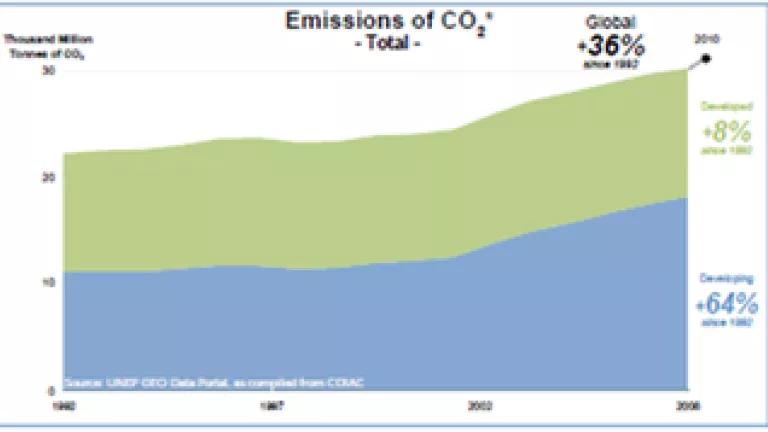Phase-out fossil fuel subsidies and deploy renewables: key global warming actions to implement at Earth Summit 2012 (Part 1)

NRDC joined with over 600 countries, organizations, international organizations, and others in submitting its views on what world leaders, CEOs, and citizens should accomplish at the Earth Summit 2012 in Rio de Janeiro, Brazil (submissions are still rolling in so check out the tally now). We don’t want vague promises and new documents – we want action. We asked that the gathering of world leaders in Rio de Janeiro next June produce concrete results: “Rio+20 should generate real actions on the part of governments at every level, as well as by businesses and civil society groups, to immediately deliver the necessary actions to put us all on a more sustainable path.” Basically if you aren’t prepared to take on new actions or deliver on old ones then don’t show up.
This Summit comes at a critical time. A new report from the United Nations Environment Program, Keeping Track of our Changing Environment: From Rio to Rio+20, highlights some of the trends for a variety of indicators including global warming. The report points out that global carbon dioxide emission have increased by 36% between 1992 and 2008. And a recent study found that between 2009 and 2010 the world witnessed the “biggest jump ever seen in global warming gases”. While these are some depressing trends going into the Earth Summit 2012, there are some tangible global warming and clean energy actions that can be taken over the next seven months on the “Road to Rio” that are both achievable and could help to reduce carbon pollution.
[This is a part of a series of posts on some of the key global warming and clean energy actions that should be implemented at the Earth Summit 2012. Part 2 will look at additional actions.]
PHASE-OUT FOSSIL FUEL SUBSIDIES
In 2010, $409 billion in subsidies were provided for fossil-fuel consumption, according to the International Energy Agency (click here for a great online database by country). In addition, around $100 billion in subsidies are provided globally per year for fossil-fuel production.* Eliminating these subsidies would make a significant dent in curbing global warming pollution. For example, eliminating just the subsidies for consumption would reduce carbon dioxide emissions by almost 5 percent by 2020 – 1.7 gigatonnes of CO2 – according to the IEA.
These subsidies make it that much harder for clean energy to compete as they have to overcome these direct fossil fuel subsidies, as well as the indirect subsidies (e.g., the health damages from fossil fuel combustion). These subsidies are also a real drain on national budgets at a time of tight government budgets. And such subsidies encourage the production and use of fossil-fossil fuels and thereby increase global warming pollution. So why would countries provide subsidies for activities that contribute to global warming and that make it harder for clean energy to compete?
In total, 53 countries have taken international commitments to reform and phase-out their fossil fuel subsidies including many of the world's largest economies (see Group of Twenty (G20) and Asia-Pacific Economic Cooperation (APEC) commitments). At the Earth Summit 2012, additional countries must commit to phase-out fossil fuel subsidies and existing commitments need to be implemented by countries enshrining specific phase-out schedules in their national law (see also the joint submission from over 20 leading organizations).
DEPLOY RENEWABLE ENERGY
Renewable energy accounted for $211 billion in new investments in 2010 – an increase of 32% from the previous year. It is seeing rapid growth throughout the world. In 2010, wind, solar, and geothermal accounted for about 30% of the estimated new electricity capacity brought on line. That means that around a third of the new energy installed was generated by the sun and wind.
In the midst of this deployment, renewable energy has moved past the point of being a niche provider of electricity that is a “nice thing do if you can afford them”. According to Bloomberg New Energy Finance, the cost of electricity generated from wind is now at record lows and is cost-competitive or cheaper than coal-fired power plants in many locations. For solar, investment analysts at Bank of America estimate that the average price for crystalline silicon modules will fall by 32 percent in 2012, trumping the 25 percent decrease in 2011. So why wouldn’t more and more countries use renewable energy to meet their growing energy needs?
At least 119 countries had some type of national policy target or renewable support policy in 2010. As a result, commercial wind power exists in 83 countries – whereas just a handful had wind in the 1990s. In 2010, solar photovoltaic capacity was added in more than 100 countries. This shows that wind, solar, and other renewable energy sources aren’t some mythical source of energy that only a small number of countries can tap into. At the Earth Summit, it is critical that countries scale-up renewable energy use by undertaking specific policies and programs to speed up the deployment of clean energy in their country in order to more than triple the amount of wind, solar, geothermal, and tidal power that is used throughout the world.
[Part 2 will look at additional global warming and clean energy actions that should be taken at the Earth Summit 2012.]
--------------------
* In the twenty-four countries in the Organization for Economic Cooperation and Development (OECD), $45-75 billion per year of subsidies was provided for the production and consumption of fossil fuels (with details available per country).
** Doesn’t include hydropower which accounted for over 16% of world electricity production in 2010.
*** Oil rig photo: courtesy of tsuda. Windmill photo: V_I_M_A_L
